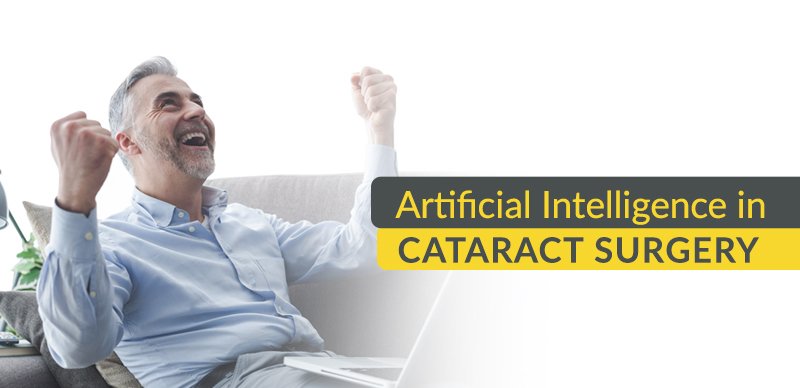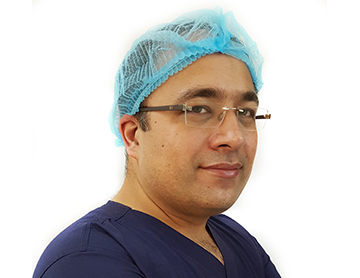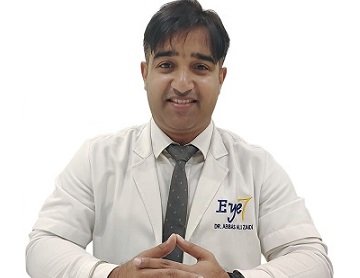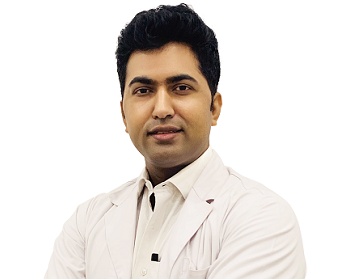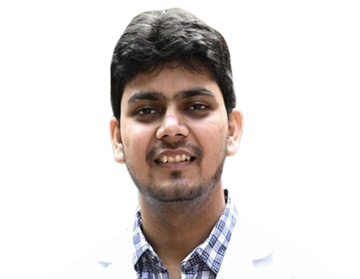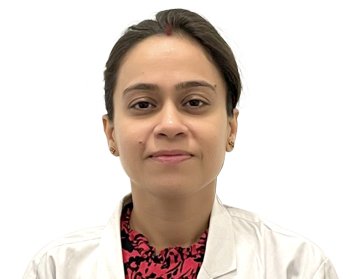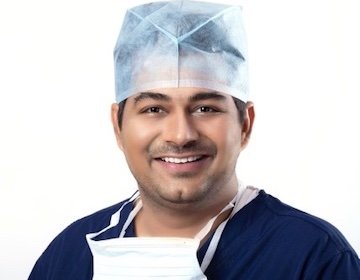Cataract is caused by the clouding of the natural lens of the eye and usually develops as a result of old age, but may occur in infants and young children too. This results in blurred vision, glare, and sensitivity to bright lights. As the disease progresses, it leads to painless, progressive decrease in vision which can also result in a poor quality of life, interfering with day-to-day activities like driving and reading.
A healthy lifestyle helps prevent cataract, but in case if it happens, it is managed by spectacles. However, as the disease progresses, or if the central vision deteriorates, the only option for its management is a surgery. Cataract surgery in Delhi entails sucking out the natural lens after emulsifying it inside the eye by a process known as Phacoemulsification. After this, a customized, artificial intraocular lens (called IOL) is placed in its position which restores natural and normal vision.
Cataract Surgery Cost in Delhi
The cost of Cataract Surgery in Delhi is from Rs 26,000 to Rs 93,000, including the cost of lens, for one eye.
| Lens Brand | Lens Type | Cost of Cataract Surgery (with lens) * | Possible Correction | Requirement of Glasses Post-surgery |
| Acriol (Care) Indian | Monofocal | INR 26,000 | Distance Only | For Computer and Reading |
| Hoya 150 (Hoya) Japan | Monofocal | INR 44,000 | Distance Only | For Computer and Reading |
| Clareon (Alcon) USA | Monofocal | INR 52,000 | Distance Only | For Computer and Reading |
| Tecnis Eyhance (J&J) USA | Monofocal + Depth of Focus (DOF) | INR 59,000 | Distance + Some Intermediate | For Reading |
| Hoya Impress (Hoya) Japan | Monofocal + Depth of Focus (DOF) | INR 67,000 | Distance + Some Intermediate | For Reading |
| Magnificent (Care) Indian | Monofocal + Extended Depth of Focus (EDOF) | INR 50,000 | Distance + Intermediate + Some Near | For Fine Print Reading Only |
| Lux Smart (B & L) USA | Monofocal + Extended Depth of Focus (EDOF) | INR 87,000 | Distance + Intermediate + Some Near | For Fine Print Reading Only |
| Vivity (Alcon) USA | Monofocal + Extended Depth of Focus (EDOF) | INR 99,000 | Distance + Intermediate + Some Near | For Fine Print Reading Only |
| Panoptix (Alcon) USA | Trifocal (Multifocal) | INR 93,000 | Distance + Intermediate + Near | No Need of Glasses |
| Panoptix (Alcon) USA | Trifocal (Multifocal) | INR 93,000 | Distance + Intermediate + Near | Loss of Contrast, Halos & Glare |
* The surgery cost is an estimated cost of one eye. The surgery is a Micro Incision Cataract Surgery (MICS). The surgery with AI Laser will cost an additional of Rs 49,000 per eye.
The price of cataract surgery depends upon the age of the person, the intraocular lens chosen as well as the previous history of eye procedures.
The exact price can be determined by visiting our hospital and getting an appointment with our cataract surgeons in Delhi who will determine the exact condition of the eyes and can give you an exact cost estimate.
Latest Surgery Options and Types of Lenses Used for Cataract Treatment
Why Choose Eye7 Chaudhary Eye Centre?
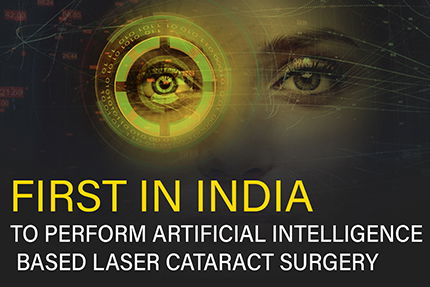

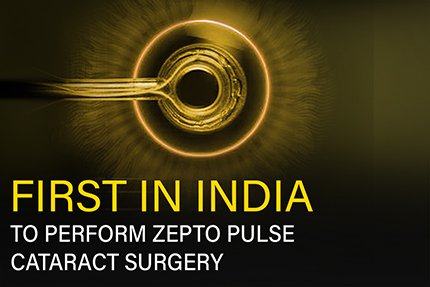
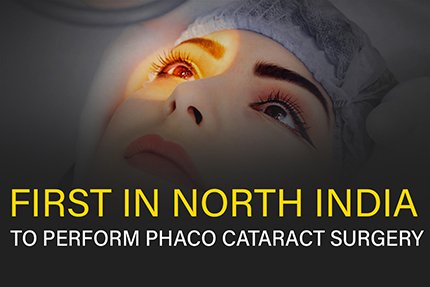
Get in touch with us to know which Cataract procedure is best for your eyes.
Who Is At a Risk of Cataract?
- People whose age is more than 60 years
- People with prolonged use of steroids
- Overexposure to ultraviolet rays
- People with Diabetes
- Eye injuries
How Do I Know if I Need a Cataract Surgery?
This is where cataract surgeons at Eye7 come into the picture. After a thorough and comprehensive eye evaluation, our doctors will discuss with you the diagnosis of cataract and your best corrected visual acuity (your vision with glasses). They will also help you judge for yourself, with trial lenses, if you are comfortable with this vision with glasses in your day to day life or not.
In case, if you are not comfortable, in the absence of any eye disease that may affect your vision, the surgeon will discuss with you the possibility of cataract surgery in Delhi, and its available techniques.
Cataract Treatment in Delhi
There is no medication for treating cataract, but surgery has long proven to be an effective treatment for the disorder. With the advancement in technology, it is now safer, to get a surgery, than ever to get your vision corrected with minimal risks involved.
The decision to have surgery depends on the degree to which your vision is impaired. Although some persons with cataracts find that their vision improves by using eyeglasses, magnifying lenses or stronger lighting. However, the only real way to cure cataracts is by surgery. If cataracts affect both eyes, each eye operation is scheduled and performed separately. The cataract operation involves two major steps
Step 1: Cataractous Lens Extraction
- Extracapsular Cataract Extraction (ECCE)
In this procedure, the cataractous lens is broken up using either a laser (latest: AI-LenSx Femto) or using ultrasound waves (Phaco emulsification). The broken lens is then extracted through a tiny hollow tube. The normal lens capsule surrounding the lens is left intact. - Intracapsular Cataract Extraction (ICCE)
In this procedure, the cataractous lens is taken out as a whole by making a big incision cut on the eye then the incision is closed using 5 to 7 stitches. This procedure has become obsolete now.
Step 2: Replacement for the Lens
Once the lens is removed, it may be replaced by one of the three options:
- An intraocular lens (an artificial lens placed in the eye during cataract surgery);
- A contact lens; or
- Special cataract glasses with very powerful magnification.
Currently, about 99 percent or more of patients use an intraocular lens.
Latest Surgical Techniques for Cataract Management Used at Eye7 Hospitals
Eye7 has always been a pioneer when it comes to the use of latest technology and techniques for surgeries. Below are the ones that can be used for the treatment of cataract in Delhi:
AI-LenSx, Artificial Intelligence Based Robotic Femto Laser Cataract Surgery
Eye7 Eye Hospital is proud to announce yet another US-FDA approved technology aimed at improving vision with cataract surgery. This new technology is called AI-LenSx, Artificial Intelligence Based Robotic Laser Cataract Surgery.
Because this technology allows artificial intelligence to make complex calculations during critical steps of surgery, the AI-LenSx contributes to predicted and improved surgical outcomes. The AI-LenSx Cataract surgery may also be able to better manage astigmatism than other types of cataract surgery.

Zepto cataract or Zepto Capsulotomy Device for Cataract Surgery
“Zepto Capsulotomy Device for cataract surgery” uses a handheld disposable device to create a precise and strong capsulotomy. It is used in special cases like Brown Cataract, White Cataract, One Eyed Patients etc.
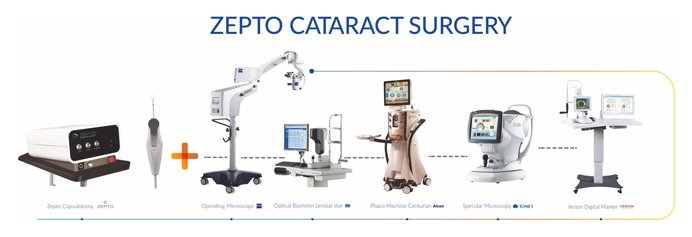
Microincision or Regular Phaco Cataract Surgery
In conventional phacoemulsification and Microincision cataract surgery, a capsulotomy is performed manually using forceps or a bent needle. It is through this opening that the ultrasound emulsifies the natural lens of the eye before it is sucked out of the eye using a vacuum. When performed manually, this capsulotomy is not perfectly circular, and in some cases, the capsulotomy may “run” to one side, resulting in a tear of the capsular bag. This means that the IOL implanted may not as stable as it should be.

PREMIUM
AI-LENSX FEMTO LASER CATARACT SURGERY
ARTIFICIAL INTELLIGENCE IN CATARACT SURGERY
| US – FDA Approved |
| Artificial Intelligence (AI) Assisted Laser Capsulotomy |
| AI-based predictability with Laser Robotic Precision & Safety |
| Blade-Less, Stitch-Less, Highest Quality Vision. |
PREMIUM BUDGET
ZEPTO PULSE CATARACT SURGERY
STITCH-LESS
| US – FDA Approved |
| Automated Capsulotomy* |
| Digital Precision & Safety |
| Stitch-Less |
MICRO OR REGULAR PHACO SURGERY
STITCH-LESS
| US – FDA Approved |
| Manual Capsulotomy* |
| – |
| Stitch-Less |
Choosing the Best Eye Hospital for Cataract Surgery in Delhi
In case you experience any visual symptoms like a decrease in vision, blurring, or glare, you should consult with your ophthalmologist to ascertain the reason. Make sure to ask as many questions as possible and when you are answering questions, be very particular about what you are exactly experiencing in the eye.
In case, you have been diagnosed with cataract, or are apprehensive that you may have a cataract, do not worry. Eye7 Chaudhary Eye Centre, which is one of the most advanced centers in the country and a top eye hospital in Delhi for cataract surgery, can offer you an expert consultation for all your eye-related problems.
We have all the three advanced techniques of painless, stitch-less and bladeless cataract surgery with IOL implantation available at all our state of the art centers that are an example of excellence in ophthalmology and are powered by the most proficient and skilled team of eye care professionals.
We are located in different parts of the National Capital Region of Delhi, and our best cataract surgeons in Delhi make sure to take good care of you.
Top Cataract Surgeons in Delhi at Eye7 Hospitals
At Eye7 Hospitals, we make sure that your health is a top priority. Our surgeons also ensure that at every step of the surgery, the patients are taken good care of, and they have all the answers to their questions. We have some of the best cataract surgeons in Delhi who have numerous years of experience and have been working with us for a very long time.
Frequently Asked Questions about Cataract Treatment in Delhi
There is a painless gradual decrease in vision. Early cataract is associated with difficulty in reading in normal light conditions, and extra illumination is required. Excessive glare and reduced sharpness can make night driving difficult. Some experience a rapid changes in the number / power of glasses. In advanced cases there is complete loss of sight and lens becomes pearly white in colour.
If you experience any of the following issues, schedule an appointment with your eye doctor immediately:
- Cloudy or blurry vision
- Double vision (diplopia)
- Fading of colours
- Seeing halos around lights
- An increased sensitivity to glare
- A distortion of vision that makes objects appear as if you’re looking at them through a veil.
There is a painless progressive reduction of vision. Initially some help is achieved by changing the spectacle number, but in advance cases the spectacles also prove to be ineffective. Cataracts are the world’s leading cause of blindness, accounting for approximately 42 percent of all cases of blindness in all the countries, luckily its easily treatable in the present age through a simple surgery.
Cataract is a long-term problem that usually starts developing around the age of 40 and intensifies by the time an individual attains the age of 50 to 60. It is also caused by eye-trauma, long-term diabetes, corticosteroid medications or radiation treatments.
Some infants are also afflicted by cataract, which is caused as a result of infections during pregnancy. The disorder can also be a symptomatic of metabolic disease affecting the body’s processing of carbohydrates, amino acids, calcium or copper among infants and young kids. If left untreated, cataracts might also lead to blindness.
There is no medication for treating cataract but surgery has long proven to be an effective treatment of the disorder. With the advancement in technology, it is now safer than ever to get your vision corrected with minimal risks to your vision.
The decision to have surgery depends on the degree to which your vision in impaired. Although some persons with cataracts find that their vision improves by using eyeglasses, magnifying lenses or stronger lighting, the only real way to cure cataracts is by surgery. If cataracts affect both eyes, each eye operation is scheduled and performed separately
The common surgical procedures are:
- Extracapsular cataract extraction. In this procedure, the lens is either broken up using ultrasound waves (a process called phacoemulsification, or phaco), then extracted through a tiny hollow tube, or it is removed in one piece. The normal lens capsule surrounding the lens is left intact.
- Intracapsular cataract extraction. In this technique, both the lens and the lens capsule are removed. This technique is now performed only in very rare cases.
Once the lens is removed, it may be replaced by one of three options:
- An intraocular lens (an artificial lens placed in the eye during cataract surgery);
- A contact lens; or
- Special cataract glasses with very powerful magnification.
Currently, about 99 percent or more of patients use an intraocular lens.
Modern cataract surgery takes just a few minutes to administer and the recovery period is also minimal. In the first week after surgery, it generally is recommended that the patient keep his or her eye covered at all times, either with eyeglasses or an eye shield, to protect it from being bumped or rubbed. A small amount of pressure can easily open the incision, and protecting the eye prevents this. The patient is also asked to refrain from
- Bending with the head below the waist,
- Lifting more than 10 pounds, and
- Straining (on the toilet, for example) to the point of holding one’s breath.
A few weeks after the surgery, the patient may be prescribed glasses for near work. The artificial lenses last a lifetime and complications due to the lens are rare and are easily corrected.
Call your eye-doctor whenever you have trouble seeing clearly. If you are older than 40, schedule an eye examination with your doctor every two years, even if you have not noticed any change in your vision.
There is usually no visible scarring but at times the white of the eye can have any degree of redness
You may go home with an eye pad and shield, or just a shield. The pad can be removed after the first hour. The shield should be worn at night for the first week.
The eye may feel gritty and sometimes you may experience some mild headache. These symptoms are common. The discomfort should rapidly improve over the next 24 hours. There should be no worsening of your symptoms. If your discomfort or headache should deteriorate, contact your doctor immediately.
Your vision will normally be much better by Day 2. Sometimes there can be some blurring or misting in the eye, but this should improve over the course of the day. If you feel your vision is becoming more blurred, contact your hospital immediately.
If you take part in a sport that risks a poke in the eye, you should discuss returning to these activities with your surgeon before the operation. You should not go swimming for the first 2 to 4 weeks to minimize the risk of infection. When cycling in the first few weeks following surgery, keep your sunglasses on to reduce the impact of dust.
The majority of patients with cataracts are elderly and usually retired from work. Cataracts can, however, also occur in much younger patients.
Every person recovers differently and has different needs. Cataract surgery normally has a very quick recovery and the majority of individuals can normally get back to work almost immediately.
Jobs that are more physically demanding and involve exposure to liquids or dust might require a more graduated return to full activities, but are best discussed with your surgeon.
The lens which is placed in the eye is of a fixed power. The power of the lens for a particular eye is calculated with the help of an eye ultrasound. After surgery, routine distance activities can be carried out without glasses. For reading, glasses would be required.
You may opt to chose for lenses which provide you vision for distance and near. in such cases dependency on glasses are reduced.
Yes. These are called multifocal intra-ocular lenses or extended range sense sand give good vision without glasses for distance and reading. However in certain eye condition, a need for using a little spectacle correction may be felt for very fine work.
It is easier and safer to operate on an immature cataract. As the cataract matures, it tends to become harder requiring more energy to do the same job. Beyond a certain limit, excess energy may cause harm to the eye.
Yes.
Foldable (soft) lens has a diameter of 6.0 mm and is made of either Silicon or Soft Acrylic. It can be injected through a needle into the eye through the 2.2 mm opening made for the surgery. The lens unfolds automatically to take its position. Non-foldable (hard) lens has a diameter of 5.5 mm. A 2.2 mm incision has to be enlarged to 5.5 mm to introduce this lens. However the incision still remains self-sealing and requires no sutures, but it may induce some curvature changes in the eye.
The Blood Pressure (BP) and Blood Sugar should be in control. E.C.G and a medical checkup may be required in some cases.
Today, cataract surgery is not simply about removing the cataract from eye and replacing it with an IOL (Intra Ocular Lenses). A lot depends on a near perfect IOL power calculation. The vision can therefore be customized to suit your requirement i.e. distance dominant, near dominant or intermediate. There are two ways to calculate the IOL power
The Ultrasound method
Here an ultrasound machine called an A scan is used. The eye is numbed with anesthetic eye drops and the ultrasound probe in a water shell is brought in close approximation to the eye (immersion technique). The moment the probe is in the right position, 10 rapid readings are taken in quick succession. The best reading is picked up for calculations.
The Optical method
Here an optical biometer like the lenstar is used. A diode laser light is passed into the eye, and the reflection echo are noted by a special sensor. The time taken to record the reflected echo is interpreted as the axial length of the eye which determines the IOL power calculation. This technique is highly accurate, and is considered the gold standard for IOL power calculation. Both the above methods are used in our major centers to cross check the calculations. (corrections for this page by web designer : the first picture will be replaced by the ultrasound machine and underneath write ‘Ultrasound A Scan’. Under the second picture write ‘Optical biometer – Lenstar).
Cataract surgery has now become a refractive surgery and the goal is not just to to remove the opacified cataractous lens but also to reduce dependency on glasses.
A routine Cataract surgery can only correct the spherical component of the eye leaving behind the cylinder power which has to be later corrected by additional prescription glasses.
With advancements in surgical techniques and IOL (artificial lens) designs, today both spherical and cylinder components of eye can easily be corrected with highest precision
The cylinder component in Cataract Surgery can be corrected by three ways
- LRI or Limbal Relaxing Incisions: In this technique, a Femto Laser is used to give highly precise incisions at the periphery of the cornea to induce cylinder correction. Since these incisions are given by a laser, it can only be coupled with a Femto Cataract Surgery.
- Toric Lenses with Verion Digital Axis Marking: Toric lenses are special lenses which have both cylinder and spherical component build in one lens. Since cylinder axis varies in individual eyes, the lens has to be aligned to specific axis of the individual. In such cases even a minor deviation from the original axis can cause significant disturbance in final visual outcomes.
Now with the introduction of Verion Digital Axis Marking system, these toric lenses can be aligned with outmost precision, upto 1 degree.
- Toric Lenses with Manual Marking: As discussed above, the final visual outcome in a toric lens depends on how precisely it is aligned to the original cylindrical axis of eye. Since the manual markings cannot be as precise as digital markings, the manual system may give slightly inferior results compared to the digital system.

